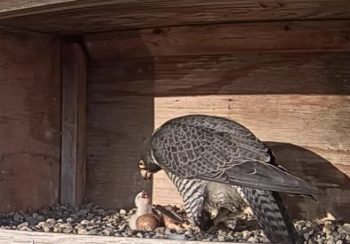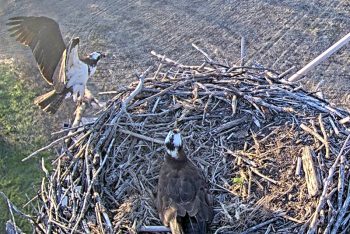Catching up with OPPD’s resident raptors

Editor’s note: This story updated May 8 when the first chick at North Omaha Station hatched.
OPPD’s power plants have become quite the hotspot for raptors seeking a nice home, affordable rent and stunning views.
A peregrine falcon pair recently found a comfy space in the new nesting box at Nebraska City Station. Ospreys have returned to their usual spot atop a pole at Fort Calhoun Station. And Lewis and Clark, the longtime residents of North Omaha Station, are back on their perch overlooking the Missouri River.
Clark, the resident peregrine falcon at OPPD’s North Omaha Station, is a new mother once again. One of her chicks hatched May 8 and appears to be doing well. Clark and her mate, Lewis, have struggled in recent years to reproduce successfully.
The osprey eggs should hatch in early June. You can keep track of Lewis and Clark and the ospreys on their respective YouTube channels.
“They’re fun to watch,” said James Thiele, OPPD’s Wildlife and Natural Resources Program Manager.
The falcons primarily hunt smaller prey birds, while ospreys eat fish from nearby rivers and ponds. During last year’s flooding, the ospreys were seen eating a lot of gar. Ospreys will eat nearly any fish, from carp to panfish.
Falcons at Nebraska City Station
Thiele said he hasn’t learned much yet about the raptors at Nebraska City Station. Peregrine falcons have taken up residence in a nesting box installed at the plant in 2023, but their origins and whether they’re banded remain unclear. Thiele added insulation to the box to protect it from the sun and keep it from becoming too hot.

Observing those peregrines is challenging right now given the box’s location and the importance of disturbing them as little as possible. OPPD doesn’t currently have a camera for the raptors at that site.
Clark and Lewis have faced misfortune recently with their attempts to produce new offspring. Some of their eggs never hatched, and the chicks that did barely ate and appeared to be sick and weak. All died over the last two years, although Clark did her best to help them thrive. Lewis and Clark have successfully raised nine surviving chicks at North Omaha Station.
“She’s a good mother, and once they hatch, she takes very good care of them,” said Jerry Toll, a seasoned falcon observer who has banded OPPD’s peregrines.
The female osprey at Fort Calhoun laid three eggs last year; two chicks hatched and successfully fledged. One egg remained unhatched. The ospreys have three eggs again this year.
Taking turns incubating
Clark is 14 years old now, and wildlife experts who have followed her life suspect she isn’t able to produce successful offspring as easily. Lewis and Clark’s mother, who for many years was the resident female falcon at the State Capitol in Lincoln, started producing eggs that weren’t viable as she aged. Chicks would hatch but die soon afterword. Eventually, she stopped laying eggs altogether.
But for now, she’s busy feeding her new chick and incubating the remaining three eggs. Thiele cleaned the falcon box this year before Lewis and Clark returned to try to remove any parasites that could hurt the young.
Toll said the falcons will likely stay around the nest throughout the summer, regardless of whether their offspring survive.
“That’s their home base and that’s where she stays,” he said.

Grant Schulte joined OPPD as a content generalist in 2022. He is a former reporter for The Associated Press, where he covered the Nebraska Legislature, state politics and other news for a global audience. He is a graduate of the University of Iowa and a proud Hawkeye. In his free time he enjoys running, reading, spending time with his wife, and all things aviation.
View all posts by Grant Schulte >







